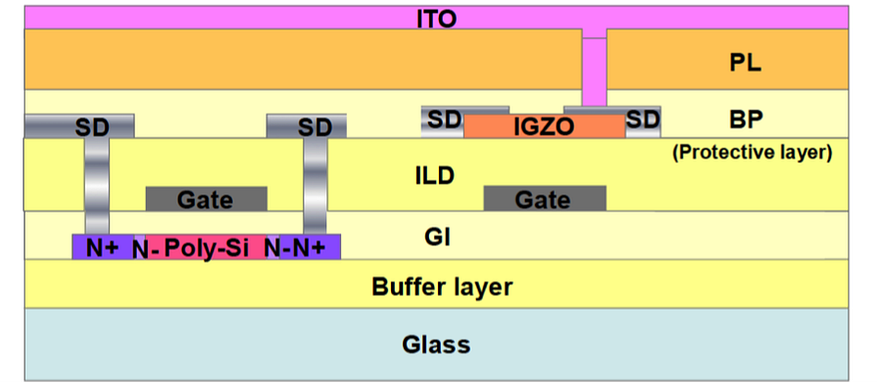
Apple’s new Apple Watch has a display unlike any other smartwatch. A low-temperature polycrystalline oxide (LTPO) display is a special kind of backplane technology designed for OLED screens and developed by Apple.
It was introduced with the Series 4 Apple Watch and is a critical part of how the new Apple Watch Series 5 is able to offer an always-on display experience without completely killing the battery life.
IHS’s claim that LTPO would reduce the power consumption by 10%-15% was not verified and the reduction apparently only relates to the power consumed by the backplane.
Figure 1: (a) Schematic cross-section of IGZO and LTPS hybrid TFTs with top gate IGZO TFTs (b) Schematic cross-section of IGZO and LTPS hybrid TFTs array technology with bottom gate IGZO TFTs
(a)

Source: AUO
(b)

Source: AUO
How does it work?
Basically, normal LCD and OLED displays rely on low-temperature polycrystalline silicon (LTPS) thin-film-transistors (TFTs) when it comes to the construction of the backplane. When it comes to AMOLED, it’s considered to be more-or-less the standard but it can be expensive.
However, the LTPO display tech found in the new Apple Watch opts for a mix of both LTPS TFTs and Oxide TFTs. The latter leverages IGZO (Indium Gallium Zinc Oxide) TFTs instead. In the world of display manufacturing, IGZO is being hyped up as the next big thing.
As I mentioned before, LTPO can be expensive and difficult to scale. IGZO offers a way forward. They boast substantially greater electron mobility, which in turn makes them easier to scale downwards into smaller sizes without a loss in performance.
IGZO is also cheaper to manufacture and capable of offering much greater pixel density than LTPS is.
Is LTPO just another name for IGZO?
Not quite. This isn’t another Liquid Retina Display.
As the acronym might suggest, LTPO is a hybrid of LTPS and IGZO. You’re getting a bit of both.
According to Apple, the new Series 5 Apple Watch has “the industry’s only low-temperature polysilicon and oxide display (LTPO), ultra-low power display driver, efficient power management integrated circuit and new ambient light sensor.”
It’s those latter components here that allow it to deliver on the always-on mode where the Series 4 couldn’t.
Which Apple products have an LTPO display?
Thus far, only the Series 4 and Series 5 Apple Watches feature an LTPO display.
However, given the suitability of the technology for smartwatches, it’ll be interesting to see if other brands playing in the space adopt it sooner rather than later.
Why are LTPO displays good?
In the case of the Series 5 Apple Watch, having an LTPO display is good because it lets apple dynamically change the refresh rate on the wearable’s screen.
If you’re looking at an interacting with it, they crank it up. If it’s idle, they only really need to refresh it once a minute or so. The end result of this tinkering is an Apple Watch that’s always on but doesn’t always eat away at your battery life.
Originally published at https://www.pcworld.idg.com.au.